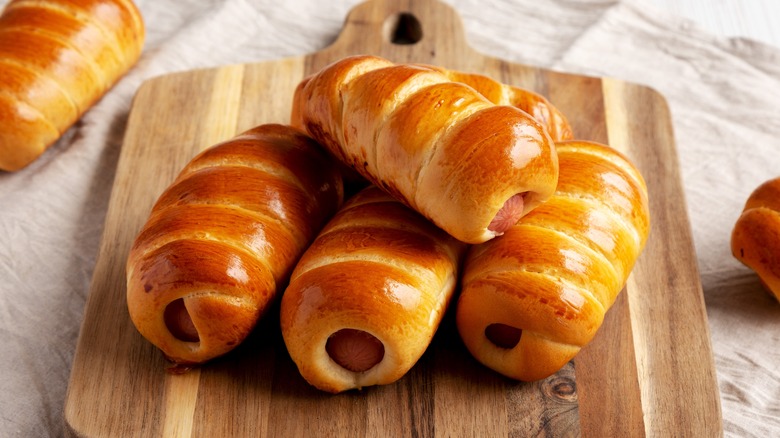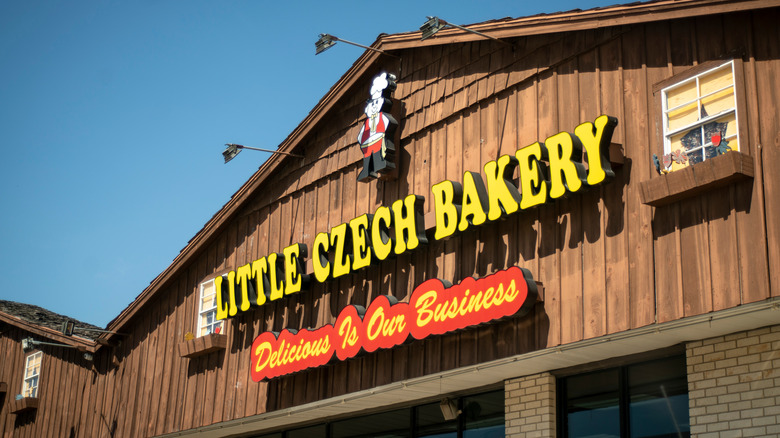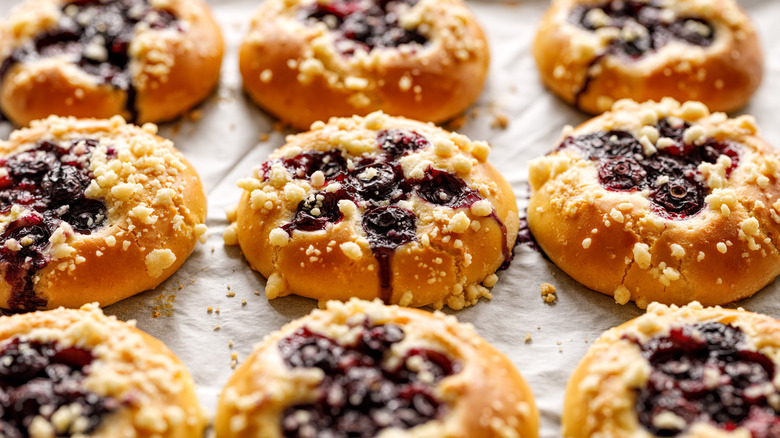Kolaches, The Czech Pastry Texans Absolutely Love
America's a great melting pot of cuisines, with beloved subgenres like Tex-Mex and Italian-American fare. And in the Lone Star State, there's another, slightly more obscure culinary exchange: Czech and Texan foods.
Most known through the delectable package of a kolache, this crossover originated as most did other American food stories — immigration. Czechs settled on the Texan plains in the 19th century, and their traditions never faded away. Now, the delicious pastry is a staple of convenience stores and roadside eateries connecting the state's major cities. For young and old Texans alike, a stop for kolaches during a road trip is a nostalgic memory.
And although many bakers still concoct the traditional sweet rendition of the pastry, they're equally known for the iconic Texas take. Stuffed with fillings like pork sausage, cheddar, and jalapeños, it brings a savory side to the fluffy bread. So, how did this spin-off originate? Let's dive into the details.
History of Texan kolaches
Kolaches originated in the Czech Republic several centuries ago and continue to be filled with farmer's cheese, fruit, and poppy seeds. Rolled into the size of a fist or even flattened into a pizza-like creation, they remain a stalwart of markets and bakeries. However, there are no renditions with pork, as is the variety commonly spotted in Texan convenience stores.
This distinct, savory rendition — fondly referred to as klobasnek — is instead a uniquely Czech-Texan creation. This interpretation traces its roots to the arrival of Czeck immigrants in the late 19th century, who settled throughout Central Texas. As both a display of heritage as well as an enterprising opportunity, these communities started opening kolache bakeries. Unafraid to relinquish old-world recipes, offering satiating cheese and pork-stuffed kolaches. These pigs-in-a-blanket adjacent pastries took off, causing an explosion of popularity all around the state. Crafted with everything from brisket to boudin, they became a convenience store staple, shaking off any traditional preparation methods — and all-encompassed by the name of kolache.
Nevertheless, especially around the town of West, generational Czech kolache bakers remain. Since 1952, the beloved Village Bakery in West has crafted traditional kolaches and is considered to have invented the wiener-stuffed variant, owning a trademark for the term klobasniki. The not-to-miss Czech Stop is another West institution, offering many motorists their first bite of the creation. And now, new local favorites continue to pop up all around the U.S., progressing the malleability of the kolache forward.
How kolaches are made
Although Texan kolaches have evolved into different shapes than the original oval-shaped Czech version, they feature a similar dough. It starts by heating milk, which is poured into a bowl containing yeast, salt, sugar, flour, and sometimes an egg. The dough is kneaded with a fork to a uniform consistency and allowed to rest for up to an hour. Next, the mixture is rolled out and divided into disks, around two to three inches in diameter. Sometimes, an egg wash is applied before incorporating the filling; other times, the pastries are brushed with butter afterward. Once ready, kolaches require around 20 minutes in the oven.
Fillings greatly vary — in the Czech Republic, farmer's cheese, poppy seed, prune, and apricot are most common. However, in the U.S., the incorporated flavors are more malleable. Pork sausage, cheddar cheese, and jalapenos are an esteemed Texan combo. The fillings alter based on each individual baker; some may also craft vegetarian sauerkraut and cheese deviations. Or they may break tradition completely and include fillings like chicken enchilada or Nutella and banana. With a slightly sweetened dough open to sweet and savory interpretations, it is no surprise the pastries become a blank slate for creativity.


